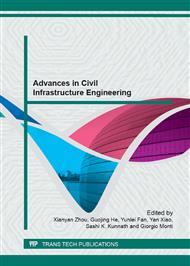p.429
p.434
p.444
p.452
p.456
p.460
p.470
p.474
p.481
Study on Critical Speed of Freight Train Derailment on Bridges
Abstract:
The mechanism of train derailment was demonstrated to be the loss of lateral vibration stability of train-bridge (track) system. Based on the theory of energy increment analysis for system movement stability, the energy increment criterion for derailment evaluation and the method of analyzing critical speed of train derailment Vcr were presented. The critical speed of empty freight train on Laoluanhe bridge, Huanghe bridge and Youshui bridge were calculated as 65.2 km/h,64.8 km/h and 66.5 km/h respectively, which were close to actual derailment speed. It is manifested that the method of analyzing critical speed of train derailment is reasonable. According to the calculated results of the critical speed on bridges with different lateral rigidity, it is testified that the critical speed of train derailment rises with the bridge lateral rigidity strengthened. The measure to prevent derailment on bridge is to ensure enough bridge lateral rigidity to meet the running safety of train.
Info:
Periodical:
Pages:
456-459
Citation:
Online since:
January 2013
Authors:
Price:
Сopyright:
© 2013 Trans Tech Publications Ltd. All Rights Reserved
Share:
Citation:


